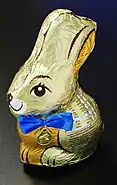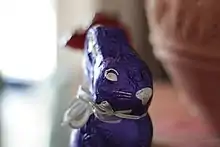Chocolate bunny
A chocolate bunny or chocolate rabbit is a piece of chocolate in the shape of a rabbit, usually stylized, and generally hollow.[1] The cocoa confection is related to the religious Easter holiday that occurs annually around the months of March and April.[2] The chocolate shaped bunny can be wrapped in a colorful tin-foil, a decorated box, or simply the chocolate itself.[1]
History
The notable Easter Bunny was introduced to Christians by German folklore in the early 13th century.[3] Stories of an egg-laying white hare fostered the popular egg and rabbit Easter theme and traditions.[3] In the Bible, rabbits are known for being a sign of fertility and new life in which the chocolate bunny now denotes to.[3] Chocolate bunny molds are believed to have been first introduced in Germany and later brought to America.[3] By the early 1920’s chocolate bunnies became an household tradition in the United States to commemorate the holiday.[4]
Preparation
Two separate bunny-shaped molds are filled with chocolate, which will later be connected to create the common hollow chocolate bunny shape.[1] Once the molds are filled, machines shake the chocolate around to ensure complete and even filling.[1] Many companies often wrap the hardened chocolate bunny in decorated foil to ensure freshness, while still being festive.[1] The bunnies often come in cardboard and plastic packaging to ensure the delicate chocolate does not break.[1]

Sales
Chocolate is one of the most commonly sold treats around the national Easter Holiday; in some years, chocolate sales can surpass $400 million a few weeks before the holiday.[6] Chocolate bunnies can be found for sale in many drugstores and grocery stores in America a few months or weeks leading up to Easter. The religious holiday comes in second place, after Halloween, for selling the most candy during a holiday season.[7] Today, the chocolate bunny is a staple for many Easter baskets around the world. More than 50% of people in the United States prefer chocolate bunnies and eggs over other candies as their choice of an Easter treat.[2] Due to their overwhelming popularity, over 90 million chocolate bunnies are produced yearly for consumers in the United States.[7]
Controversy
There have been cases of choking and illness from the decorated foil the bunnies are often wrapped in, as well as concern regarding child exploitation marketing and exposure to early obesity linked to the popular chocolate.[8] The Easter Bunny character is similar to the famous Santa Claus figure used during the Christmas season, particularly in the United States and Europe, to market products and signify the holiday. Some studies claim the Easter Bunny figure, which is a staple for the Easter chocolate and candy, is another example of child exploitation in holiday marketing techniques.[8] Cases of choking related to foil wrappings used by chocolate bunnies and eggs have been reported and are another concern for some regarding the confection.[9]

References
- Lindt Chocolate World (7 April 2015). "How is the LINDT Goldbunny Actually Being Made". Youtube.com. Retrieved 15 October 2020.
- "Confectioners Reveal Sweet Insights for The Easter Holiday". NCA. Retrieved 2020-10-16.
- "Easter Symbols and Traditions - Easter Bunny, Easter Eggs & Christianity - HISTORY". www.history.com. Retrieved 2020-10-16.
- "Chocolate Bunnies, History Of". Purdys Chocolatier. Retrieved 2020-10-16.
- Knapper, Rainer (30 January 2012). "Schoko-Osterhase IMGP1551 smial wp.jpg". Wikipedia Commons. Retrieved 26 October 2020.
- "Beyond the Bunny: Easter Drives Growth in the Candy Category". www.nielsen.com. Retrieved 2020-10-16.
- "90 Million Chocolate Bunnies and Other Fun Easter Facts". ABC News. Retrieved 2020-10-16.
- Grills, Nathan J (18 April 2011). "The Easter bunny and the chocolate conspiracy". Medical Journal of Australia. 194 (8): 410–412. doi:10.5694/j.1326-5377.2011.tb03032.x. ISSN 0025-729X.
- Naunton, Mark (20 June 2011). "The Easter bunny and the chocolate conspiracy". Medical Journal of Australia. 194 (12): 672–672. doi:10.5694/j.1326-5377.2011.tb03173.x. ISSN 0025-729X.
- Pink, Daniel (12 April 2009). "Easter Bunny". Flickr. Retrieved 29 October 2020.
